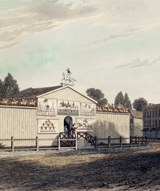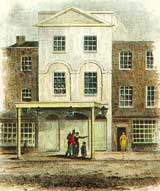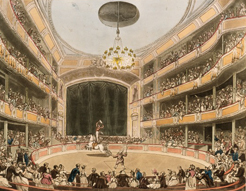by Pascal Jacob
Blow your horns and trumpets, bang your drums and snare drums! On the 4th of April 2018, the modern circus will be celebrating its first quarter of a millennium!
It was in the sacred year of 1768 that a newly discharged officer of Her Majesty chose to become an entertainer by drawing a circle in the grass and in the soil a stone's throw away from Westminster Bridge. Dressed in red, with a tricorn on his head, and in black boots, Philip Astley stands on Gibraltar, his dashing horse, and offers his fellow men a demonstration of virtuosity, and at the same time founds... the modern circus!
"Modern" as opposed to "Antique": the analogy is in no way fortuitous and the young officer chose the term amphitheatre to ennoble his cavalry prowess, sensitive to current trends towards the Antiquity supported by the many discoveries and exhumations of objects, especially in Italy.
After all, we must admit that the founding father of the modern circus did not give it its name... It was one of his rivals, Charles Hughes, who in 1782 engraved the now mythical term "Circus" on the pediment of his own establishment, adding the word "Royal" just before it. Hughes addresses the same considerations as Astley by also adopting an explicit reference to the Antiquity, but without knowing that his choice would be the right one and would gradually turn into circus, circo, cyrk, circul, cirkus, sirkus, zirkus, and so on.
Etymologically, the word circus comes from both the ancient Greek krikos, ring, and, more prosaically, from the Latin circus, a way of associating the notions of circle, circularity, but also and especially a form of circumambulation, assimilated to a rotation from an axis. The ancient circus, a vast arena, which was not circular but oval, found its full justification there: the chariots were moving around the spina, the central part and longitudinal axis of a very impressive playing area.
This notion of axis is fundamental for the modern circus: it conditions the organisation of the play area, the ring, where the riding school master, firmly camped in the centre, regulates the horses' appearance by striking them with his stock whip, in other words a whip that is around six metres long. It is probably the length of the stock whip that determines, from 1779, in the heart of the Astley Amphitheatre, the final and accepted diameter of the ring, a perfect thirteen-metre circle, a dimension considered ideal for horse-riding acrobats. Therein lies the universal character of the circus, in this unchanging diameter that offers squires and acrobats alike the same playing field, whether they are in London, Paris, Prague, Moscow, New York or Berlin...
- Un soir chez Astley (25 avril 1786) : les anciens cirques, first published in London by J. Adamson, then in french by Maison Quantin (Paris), in 1887.







